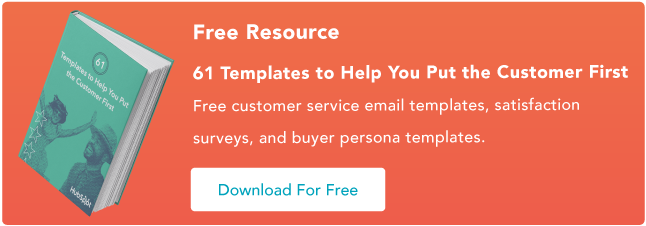HubSpot’s 2024 State of Service survey told us a lot about service leaders’ views on customer experience. But one statistic stood out to me: 56% of survey respondents said they plan to increase their investment in fostering an engaged community of customers.

So, what are the benefits of customer engagement, and what’s the best way to go about it?
![→ Free Download: 61 Templates to Help You Put the Customer First [Download Now]](https://no-cache.hubspot.com/cta/default/53/a66c79d4-2a39-46e6-a80a-f7b999133c06.png)
In my 18+ years as a sales strategist, I’ve used customer engagement campaigns to drive sales and win repeat purchases, and my re-engagement strategies have helped bring inactive prospects back from the brink. Here’s what I’ll share with you today:
Table of Contents
- What is Customer Engagement?
- Benefits of Customer Engagement
- How to Engage Customers
- How to Re-Engage Customers
What is Customer Engagement?
Customer engagement can be defined as communicating in a way that builds relationships with consumers — or, in stronger terms, the act of creating an emotional connection with them.
Re-engagement follows the same idea, with one key difference: It involves communication that brings inactive customers, or those who have churned, back to the fold.
In business, the value of building emotional connections through engagement and re-engagement can’t be understated. According to a Gallup study, 70% of a customer’s brand preferences and decisions are emotional, while only 30% are rational.
To help you kickstart your own customer engagement strategy, I’ll share some of my top tips on engaging and re-engaging customers. But before that, let’s take a deeper look at why it’s important to have engaged customers.
Benefits of Customer Engagement
- Greater Customer Retention
- Higher Revenue
- Improved Customer Satisfaction
- Better Customer Insights
- Increased Customer Base
Greater Customer Retention
Customer retention continues to be a major concern of businesses today, as demonstrated by HubSpot’s State of Service Report 2024. In that survey, 20% of respondents said that preventing customer churn was one of the top obstacles to providing an exceptional customer experience.
So, how does retention benefit customer engagement and re-engagement? From my experience, customer retention and engagement go hand in hand. If you can keep buyers interested in what your company has to say, you’ll be top of mind when they’re ready to make a purchase in the future.
Higher Revenue
To me, this one is a no-brainer: If customers stay focused on your brand (for the right reasons), you’ll improve your bottom line. Emily Rugaber, vice president of marketing at guest engagement platform Thanx, shared that engaged customers have a greater customer lifetime value than unengaged customers.
Rugaber went on to provide her rationale for the revenue-boosting potential of engagement, saying, “They [engaged customers] tend to buy more, are less price-sensitive, more likely to travel or spend more for your items, and are willing to recommend your products or services to others.”
.png)
61 Templates to Help You Put the Customer First
Email, survey, and buyer persona templates to help you engage and delight your customers
- 6 buyer persona templates
- 5 customer satisfaction survey templates
- 50 customer email templates
Download Free
All fields are required.
.png)
Improved Customer Satisfaction
When I asked Lina M. Tonk, chief marketing officer at Recurly, what she thinks engagement brings to the table, she put customer satisfaction high up her list, before highlighting the domino effect that engagement can have.
She said, “When customers feel connected, valued, and involved, their overall experience improves significantly. Satisfied customers are more likely to engage with [your] brand, provide positive feedback, and become loyal advocates.”
Better Customer Insights
When you engage your customers, you find out more about what they want. This doesn’t have to be a direct 1:1 engagement, but it helps. For example, if you communicate with your customers directly, like through email, chat, or phone calls, you can actively listen to them and show you care.
Increased Customer Base
In my career as a sales strategist, I’ve found that engaged customers are more likely to become brand ambassadors and recommend products or services to others.
Whether existing customers provide word-of-mouth recommendations, write glowing product reviews, or simply interact with your company online, the end result is the same — more potential customers for your business.
How to Engage Customers
- Communicate with customers on social media.
- Provide self-service resources.
- Build a community forum.
- Create loyalty incentives.
- Provide valuable resources to customers.
- Email your customers.
- Leverage AI.
- Meet customers face to face.
1. Communicate with customers on social media.
Many of my most successful customer engagements have centered around social media, with LinkedIn being my preferred option. However, the best one for you will depend on your customer base.
Here’s an example of social media engagement that’s not for the faint-hearted. Low-cost airline Ryanair uses social media engagement to poke fun at its own reputation … often at the expense of customers:

I find that engagement-driven social media campaigns allow me to reach customers directly, and I can get valuable engagement metrics (e.g., likes, follows, and views) to see what’s working for me.
In addition to posting and interacting on social media as a marketing tactic, you should use social as a customer service channel.
HubSpot’s survey showed that 41% of respondents use social media to offer customer service, which is more than those who provide phone support (38%). Plus, 85% saidsocial media is effective for customer service (and 42% said it is very effective).
By providing customer support on various social media platforms, you offer additional touchpoints for engagement.
Pro tip: Take the time to respond to customer comments on your social media posts. From my experience, customers react well when I reply to them individually, even when I’m sharing what could be considered bad news.
For example, if a customer replies to a post by saying, “Are your services available in California?” you can say something like, “Not yet, [Customer name]. But we hope to offer our services there next year. Subscribe to our mailing list for updates!”
2. Provide self-service resources.
I recommend creating a knowledge base for customers to boost their engagement with your brand. It’s crucial to keep your knowledge base updated and ensure that it conforms to search engineoptimization(SEO) best practices.
When you provide self-service knowledge bases and other support options, you give consumers the opportunity to direct their own engagement with your brand. It’s no wonder that 43% of service leaders plan to offer more self-service resources to boost their customer experience.
When designing self-service resources like a knowledge base, I recommend a clean layout that’s easy to navigate. Here’s Coursera’s Support Center for reference:

3. Build a community forum.
When loyal customers engage with other customers and your staff through a community forum, they’re strengthening their ties to your company.
A community forum with a strong following offers a chance to discuss product launches, find out about use cases from other customers, and get quick solutions to their problems. You can even reward top contributors to further drive their brand loyalty and engagement.
The Shopify Community is a great example. It has search functionality and various boards, so customers don’t need to sift through tons of information that isn’t relevant to them.

Pro tip: Monitoring community forums is a great way of getting valuable customer data. Even a basic post like, “Is the app down for anyone else?” can prompt members to provide information on things like user experience and customer expectations.
4. Create loyalty incentives.
HubSpot’s survey asked service professionals what their top customer experience goals were. The most popular answer? Increased customer loyalty (31%).
Implementing a customer loyalty program is a great way to keep buyers engaged with your brand, and you’ll drive sales, too. That said, you need to think about what your audience actually wants in terms of loyalty incentives.
I’ve helped develop loyalty programs for business-to-consumer (B2C) and business-to-business (B2B) markets, and I’ve found the two should be approached differently, with special attention given to your customer base and industry.
For example, an ecommerce consumer might appreciate transactional benefits, like free shipping, while a high-value business customer could prefer experiential benefits, like priority services and personalized offers.
Uber offers point-based rewards and benefits at its various membership levels (Blue, Gold, Platinum, and Diamond). This encourages reward-based loyalty and helps boost revenue.
5. Provide valuable resources to customers.
Everyone loves a freebie, whether they’re a new or current customer. Depending on your target audience, you can publish case studies and stat-backed industry reports or even offer basic tools that help small businesses with time-consuming tasks.
For example, HubSpot provides 73 free business Exceltemplates that anyone can download after providing a few details, like their email address. When customers are using HubSpot’s free products, they’re already seeing the brand’s value without spending a cent.

When you share resources that require some information from consumers, like their company role, business size, and email address, you also find out more about them, helping you build relationships with them and drive engagement.
And what do you do with those all-important email addresses? That’s right, you should ….
6. Email your customers.
Is email still a useful tool for engaging with customers? Well, 89% of service leaders say it’s effective for providing customer service.
But you don’t have to stick to just service-orientated emails. For example, you can deploy email marketing strategies, like email newsletters and drip marketing, to target people at different stages of the customer journey.
I reached out to Aaron Watters, CEO of Leadhub, for advice on drip marketing for customer engagement. He said, “My biggest tip is to make your drip sequences as customer-centric as possible. Don‘t just talk about yourself. Focus on solving the customer’s problems and making their lives easier with valuable tips, relevant resources, and exclusive deals.”
Pro tip: If you know a customer’s date of birth, email them with a personalized birthday message. Feeling generous? Attach a gift, like a voucher or special offer.
.png)
61 Templates to Help You Put the Customer First
Email, survey, and buyer persona templates to help you engage and delight your customers
- 6 buyer persona templates
- 5 customer satisfaction survey templates
- 50 customer email templates
Download Free
All fields are required.
.png)
7. Leverage AI.
No, I don’t mean getting ChatGPT to write all your emails, social media posts, and blogs (yes, we can tell). Instead, use artificial intelligence (AI) technologies to help customers get the information they need quickly.
Looking around at various landing pages and knowledge bases, I’ve noticed a steady increase in AI chatbots on both B2B and B2C websites. In many cases, I find it more tempting to ask a chatbot something instead of waiting around on customer support.
But don’t just take my word for it. When HubSpot asked service professionals if AI had helped them improve their customer experience, the answer was clear: 79% said that AI helped them increase their Net Promoter Score, which is an important customer engagement metric.
Pro tip: If you haven’t invested in a chatbot just yet but I’ve convinced you of its value, check out HubSpot’s free AIchatbotbuilder, which offers 24/7 customer engagement and extra functions, like qualifying leads, scheduling meetings, and triggering email marketing campaigns.

8. Meet customers face to face.
In today’s digital era, don’t underestimate the power of in-person communication for strengthening connections. In fact, 91% of service leaders believe in-person interactions are effective for providing customer service.
As part of my customer engagement strategy, I regularly attend conferences and host small in-house events. If my clients are local, I’ll sometimes schedule one-on-one lunches to find out their pain points and see if I can help them.
Pro tip: If your location or schedule prevents you from meeting important customers face to face, do the next best thing: Schedule a video call. Real-time customer interactions, whether on screen or in a coffee shop, show customers that they deserve your full attention.
How to Re-Engage Customers
- Ask questions.
- Share a customer’s content.
- Keep unengaged customers up to date.
- Get customer feedback.
- Ask for introductions to new customers.
1. Ask questions.
If you’ve noticed that a customer’s engagement has dropped, you can reach out to spark a conversation:
“Hi [Name], haven’t heard from you in a while. How’s everything going with [project]? We have some tools that could help streamline that — let me know if I can be of assistance in any way.”
By sending a personalized message like this, you’re showing how your company can meet your customer’s needs.
2. Share a customer’s content.
If you find a customer’s LinkedIn post insightful, don’t be afraid to join the conversation to boost the reach of their post. You can comment under the post or share it with your connections with some discussion on its merits.
Truth be told, I came upon this tip by happy accident: I once shared a customer’s LinkedIn post, and the next day, they messaged me to ask about our current product offerings.
Pro tip: Don’t feign support for a LinkedIn post in the hope of an engagement boost — it’ll look transparent and suggest that you don’t truly value customer relationships.
3. Keep unengaged customers up to date.
Got a new product launch coming up? Craft a personalized email especially for customers with a waning interest in your company. You can even offer incentives like discounts for these customers to help reel them back in.
An email update aimed at re-engagement could go something like, “Hi [Name], we’ve missed you. Have you heard about our new product release? Here’s a great discount just for you.”
Pro tip: Don’t give unengaged customers too many updates — if they feel like they’re being bombarded with irrelevant daily or weekly emails, they might unsubscribe to your mailing list or unfollow you on social media.
.png)
61 Templates to Help You Put the Customer First
Email, survey, and buyer persona templates to help you engage and delight your customers
- 6 buyer persona templates
- 5 customer satisfaction survey templates
- 50 customer email templates
Download Free
All fields are required.
.png)
4. Get customer feedback.
Requesting feedback, whether it’s through a simple email or a detailed survey, is a good way to get customers engaged with your brand again.
If an unengaged customer provides positive feedback, it’ll remind them of the benefits your company brings. On the flip side, negative feedback can help you pinpoint where you can improve your customer experience.
Pro tip: I recommend letting customers know when you’ve acted on their feedback — they’ll appreciate that you’ve listened to them, and their engagement levels could increase.
5. Ask for introductions to new customers.
If you choose your customer and time wisely, the benefits of this approach are two-fold: You’ll reconnect with existing customers, and you’ll generate new leads.
When you’re seeking introductions, be honest with your customer to build trust. I might open a request for leads with something like:
“Hi [Name], I’m currently on the lookout for new prospects. If you like our product and think it could benefit anyone in your network, I’d appreciate an introduction. Thank you for your time.”
Want more resources on how to engage customers? Check out HubSpot’s Customer Engagement Guide for more best practices and some example approaches from top companies.
Keep Your Customers Engaged in 2024
As you go through my advice on how to engage customers, like email marketing, omni-channel customer support, and resource sharing, you’ll notice that no person or team has sole responsibility for engagement and re-engagement strategies.
From my experience, your business will benefit most from a multi-department approach that’s both data driven and customer centric.
We’ve heard from experts on the effects that customer engagement has on revenue, satisfaction, and loyalty, and I have one more benefit to share: If you keep your customers engaged, you won’t need to worry too much about re-engaging them.
Editor's note: This article was originally published in March 2020 and has been updated for comprehensiveness.







![What Is a Service Qualified Lead? [Definition]](https://www.hubspot.com/hubfs/what-is-a-service-qualified-lead.webp)